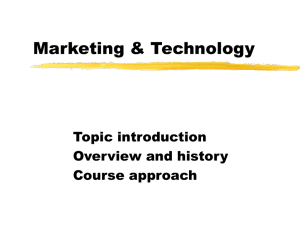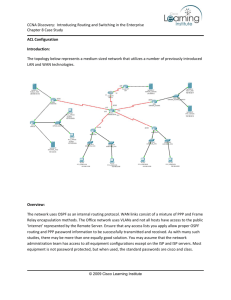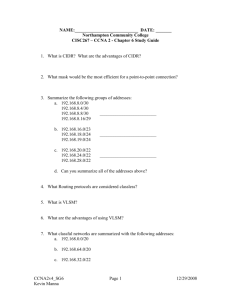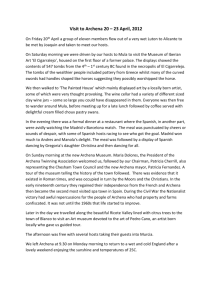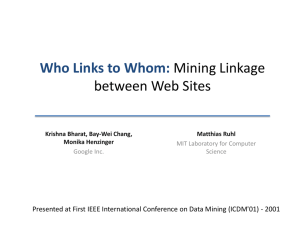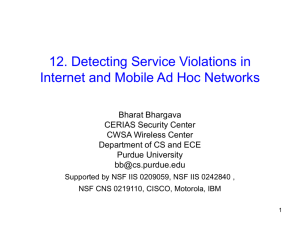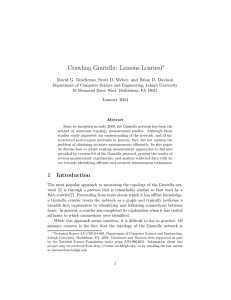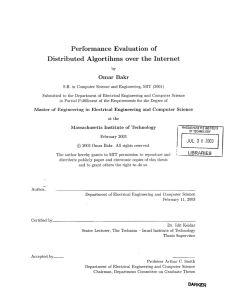itp125 - lesson 03
advertisement
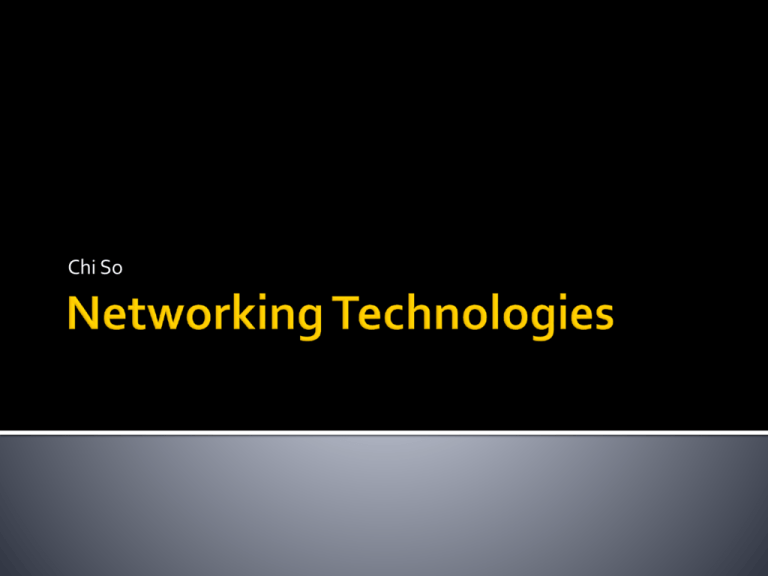
Chi So Network – a set of devices, software, and cables that enables the exchange of information between them Host Device – anything a person uses to access the network Network Device – hubs, repeaters, bridges, switches, routes, and firewalls Point-to-Point – involves two hosts or devices that are directly connected to each other and to nothing else. i.e. Serial Communication (not always) Star – one host or device has multiple connections to other hosts. Sometimes called hub-and-spoke. Anything that sends traffic through the hub or central device Ring – when one device is connected to the next one sequentially. The last device is connected to the first. Not always a true circle Data moves in a logical circle i.e. FDDI and Token Ring Bus – a single coaxial cable where hosts are attached at intervals. i.e. cable internet Mesh – multiple point-to-point connections that connect each location to the others Full Mesh – all devices are interconnected Partial Mesh – some devices are interconnected Ethernet is the most common LAN (Local Area Network) technology IEEE 802.3 Developed by Digital Equipment Corp., Intel, and Xerox. Published in 1980 Segment – A coaxial cable that joins all the hosts together Collision – when two hosts try to use the connection at the same time Carrier Sense Multiple Access with Collision Detection (CSMA/CD) – method for Ethernet to detect collusions. Listen to the line ▪ If clear, start transmission ▪ If used, wait until clear If collision occurs ▪ send jam signal ▪ Stop transmission ▪ Wait a random time before sending again (all hosts) Collision domain – a group of devices that are affected by one another’s collusions The more hosts in a domain, the more frequent the collision Bridges and switches help resolve this issue Half Duplex – Send or receive Full Duplex – Send and Receive 8 wires needed. 4 is possible Wide Area Network (WAN) Interconnect two or more LANs Usually this service is bought from another company 4 types of WAN technologies ▪ ▪ ▪ ▪ Dedicated Lease Line Circuit-Switched Connections Packet-Switched Connections Cell-Switched Connections Dedicated Leased Line A connection that is installed and provisioned for the exclusive use of the customer No other customer can affect the line Very expensive A lot of control (QoS, other traffic management) Usually point to point Protocols used ▪ Point-to-Point Protocol (PPP) ▪ High-Level Data-Link Control Protcol (HDLC) ▪ Serial Line Internet Protocol (SLIP) Circuit-Switched Connections Uses the phone company as a service provider ▪ Analog dial-up or digital ISDN connections ▪ Protocols used ▪ PPP ▪ HDLC ▪ SLIP ▪ Really slow, 19.2Kbit to 128Kbit Packet-Switched Connections Connect to the providers network Traffic is affected by others Usual technologies are ▪ Frame Relay ▪ X.25 (possible) Cell-Switched Connections Similar to packet switched Difference is the unit size of the data is fixed (cell) ▪ In packet switched networks, data units are called (frames) Dealing with traffic loads are typically easier and efficient Examples ▪ Asynchronous Transfer Mode (ATM) IEEE 802.11 Advantage: Great to eliminate cables and freedom of movement Disadvantage: range (?), reliability, security Moderate WAN distances ▪ Line of sight Metropolitan Area Network (MAN) Found in urban business centers Storage Area Network (SAN) Access an external storage array as a hard drive Expensive Content Networks Making access to the information faster Logging and controlling access to certain kinds of materials Open Systems Interconnection (OSI) model Used to standardized networking processes No rules imposed onto the manufacturers or protocol developers Only guidelines 7 Layers 7 - Application 6 - Presentation 5 - Session 4 - Transport 3 - Network 2 - Data Link 1 - Physical Any application or utility that store, send or retrieve data across a network Sometimes called the user interface layer Examples Hypertext Transfer Protocol (HTTP) File Transfer Protocol (FTP) Simple Mail Transfer Protocol (SMTP) Post Office Protocol v3 (POP3) Network Time Protocol (NTP) Simple Network Management Protocol (SNMP) Domain Name Systems (DNS) Dynamic Host Configuration Protocol (DHCP) Secure Shell (SSH) Responsible for formatting data so that the application layer (layer 7) can recognize and work with it. Examples .doc .jpg .txt .avi Deals with initiating and terminating network connections Provides instructions to Connect Authenticate (optional) Disconnect Movement of data is handled by lower layers Examples Login for Telnet, SSH, SQL sessions, RPC One of the most important layers Deals with how two hosts are going to send data. Two methods: Connection-oriented (TCP) ▪ Reliable Connectionless (UDP) ▪ Unreliable Deals with logical address (usually IP address) Other possibilities ▪ IPX ▪ AppleTalk ▪ SNA Addresses are assigned in software IP hosts can communicate if they are on the same network If different networks, need a router to communicate Finding a way to communicate between two networks is call path determination With the data unit from Layer 4, the data segment is now called a packet ( or datagram) Header has the following info: Since using logical addressing Hierarchical ▪ Organized into a formal or ranked order ▪ Easy to build a big system ▪ Build smaller systems, and put them together ▪ Example: ▪ Mailing address Protocols: Internet Protocol (IP) IPX (Novell Netware) Internet Connection Management Protocol (ICMP) OSPF, IGRP, EIGRP, RIP, ISIS (Routing Protocols) Address Resolution Protocol (ARP), Reverse ARP (RARP) Takes the Layer 3 packet and preparing a frame for the packet to be transmitted Examples: Ethernet Frame Relay Point-to-Point (PPP) High-Level Data Link Control Protocol (HDLC) Cisco Discovery Protocol (CDP) Not hierarchical Flat addressing Address are done with Media Access Control (MAC) MAC addresses are assigned in hardware Transmit the data onto a wire, optical fiber, or wireless All signaling is digital Electricity On = 1 Electricity Off = 0 Typically RJ-45
